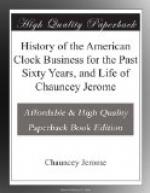The third chapter, as I have divided it, was now closing up. Wood clocks were good for time, but it was a slow job to properly make them, and difficult to procure wood just right for wheels and plates, and it took a whole year to season it. No factory had made over Ten thousand in a year; they were always classed with wooden nutmegs and wooden cucumber seeds, and could not be introduced into other countries to any advantage. But this was not the only trouble; being on water long as they would have to be, would swell the wood of the wheels and ruin the clock. Here then we had the eight day brass clock costing about twenty dollars; the idea had always been that a brass clock must be an eight day, and all one day should be of wood, and the plan of a brass one day had never been thought of.
In 1835, the southern people were greatly opposed to the Yankee pedlars coming into their states, especially the clock pedlars, and the licences were raised so high by their Legislatures that it amounted to almost a prohibition. Their laws were that any goods made in their own States could be sold without licence. Therefore clocks to be profitable must be made in those states. Chauncey and Noble Jerome started a factory in Richmond Va., making the cases and parts at Bristol, Connecticut, and packing them with the dials, glass &c. We shipped them to Richmond and took along workmen to put them together. The people were highly pleased with the idea of having clocks all made in their State. The old planters would tell the pedlars they meant to go to Richmond and see the wonderful machinery there must be to produce such articles and would no doubt have thought the tools we had there were sufficient to make a clock. We carried on this kind of business for two or three years and did very well at it, though it was unpleasant. Every one knew it was all a humbug trying to stop the pedlars from coming to their State. We removed from Richmond to Hamburg, S.C., and manufactured in the same way. This was in 1835 and ’36.
There was another company doing the same kind of business at Augusta, Geo., by the name Case, Dyer, Wadsworth & Co., and Seth Thomas was making the cases and movements for them. The hard times came down on us and we really thought that clocks would no longer be made. Our firm thought we could make them if any body could, but like the others felt discouraged and disgusted with the whole business as it was then. I am sure that I had lost, from 1821 to this time, more than one hundred thousand dollars, and felt very much discouraged in consequence. Our company had a good deal of unsettled business in Virginia and South Carolina, and I started in the fall of 1837 for those places. Arriving at Richmond, I had a strong notion of going into the marl business. I had been down into Kent county, the summer before, where I saw great mountains of this white marl composed of shells of clams and oysters white as chalk. I had sent one vessel load of this to New Haven the year before. At Richmond I was looking after our old accounts, settling up, collecting notes and picking up some scattered clocks.




